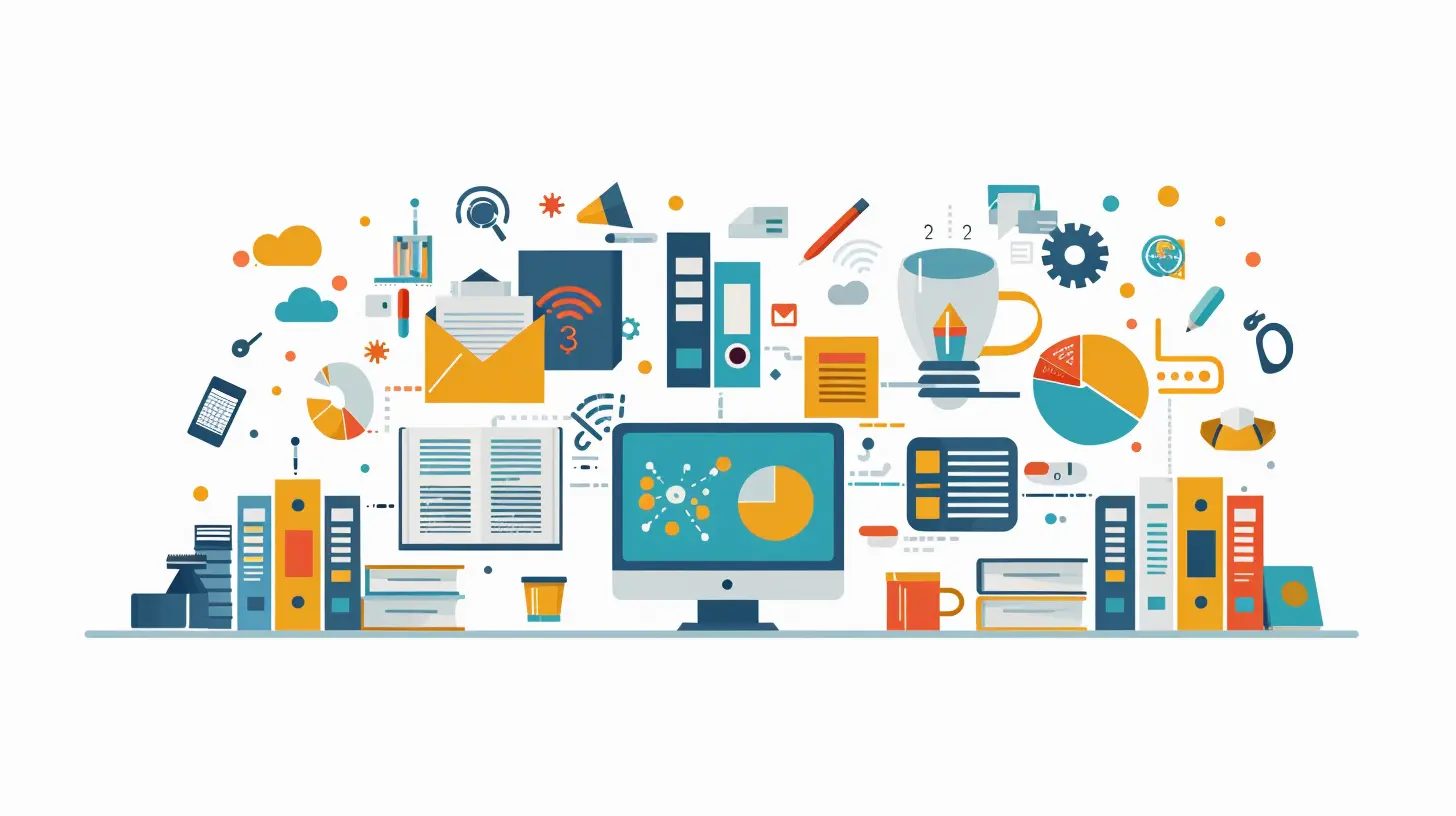The Benefits of Digital Libraries in the Age of eLearning
28 December 2024
In today’s fast-paced digital world, education is evolving like never before. Remember those days when we had to lug around heavy textbooks, spend hours in a physical library, or wait days for a book to be available? Well, thanks to the rise of digital libraries, those days seem like ancient history. Now, with just a few clicks, you can access a wealth of knowledge right at your fingertips, whether you're on your phone, tablet, or laptop.
In this article, we'll dive deep into the benefits of digital libraries in the age of eLearning. We'll explore how they’ve transformed the way we learn, study, and engage with information, especially in today’s online-driven world.

What is a Digital Library?
Before we get into the nitty-gritty, let's make sure we're all on the same page. A digital library is essentially an online database or repository of books, academic papers, research materials, multimedia files, and other educational resources. Unlike a traditional library, where you have to physically check out a book, digital libraries allow you to access content from anywhere, anytime, as long as you have internet access.Think of it as Netflix, but for knowledge. Instead of flipping through DVDs or VHS tapes (remember those?), you scroll through thousands of books, articles, and journals—all available at the click of a button. And just like streaming services have revolutionized entertainment, digital libraries are doing the same for education.

The Shift from Traditional to Digital Libraries
Not too long ago, students, researchers, and curious minds relied mainly on brick-and-mortar libraries for information. While traditional libraries are still valuable in many ways, the shift to digital has been monumental. Why? Because digital libraries offer a level of accessibility and convenience that physical libraries simply can't match.Picture this: You're working on an assignment due tomorrow, and you suddenly realize you need a specific book. In the past, you’d have to rush to the library before closing time, hoping it’s available. But with a digital library, you can instantly search for the title, download it, and get back to your work—all without leaving your desk. That’s the beauty of our modern world!

Why Digital Libraries Matter in eLearning
1. 24/7 Accessibility
Let’s face it, we’re living in a world where learning is no longer confined to the classroom. With the rise of eLearning, more students are taking courses online, participating in virtual classrooms, and pursuing degrees remotely. The traditional 9-to-5 library hours just don’t cut it anymore.Digital libraries are available 24/7, meaning you can access information whenever you need it, whether it's 2 p.m. or 2 a.m. Now, night owls and early birds alike can study on their own schedule, without the restrictions of physical library hours.
2. A World of Resources at Your Fingertips
In a traditional library, you're limited by the collection of books and materials in that particular institution. And let’s be honest, not all libraries have extensive collections. Digital libraries, on the other hand, open the door to a virtually unlimited range of resources. From rare academic papers to the latest bestselling novels, you can find almost anything.Many digital libraries also collaborate with other institutions globally, giving users access to research and publications from around the world. It’s like having a VIP pass to every library in existence!
3. Cost-Effective for Students and Institutions
Let’s talk money for a second. Textbooks and academic resources can be ridiculously expensive. For students already juggling tuition fees, living expenses, and maybe even a part-time job, buying multiple textbooks every semester can be a financial burden.Digital libraries offer a more wallet-friendly option. Many of them provide free or affordable access to a wide range of resources. Some institutions even offer students free access to extensive digital libraries as part of their enrollment, saving them hundreds (sometimes thousands) of dollars. And for institutions, maintaining a digital library often costs significantly less than a physical one. No more spending on the upkeep of buildings or replacing worn-out books!
4. Environmentally Friendly
We all know the importance of reducing our environmental footprint, right? Well, digital libraries are a step in the right direction. Think about all the paper saved by eliminating the need for printed books, journals, and other resources.In addition to saving trees, digital libraries also cut down on the energy used for shipping, printing, and maintaining physical spaces. It’s a win-win for both learners and the planet!
5. Advanced Search Capabilities
Remember the old-school library catalog system? It could take forever to find what you were looking for. In contrast, digital libraries come equipped with advanced search features, making it easy to find exactly what you need in seconds.You can filter searches by author, title, publication date, and even specific keywords. Need a scholarly article from 2015 on climate change? No problem. Want to find books by a particular author? Done. Digital libraries streamline the process, so you spend more time learning and less time searching.
6. Interactive and Multimedia Content
Digital libraries aren’t just limited to text-based resources. Many also offer multimedia content like videos, podcasts, interactive learning tools, and more. This is especially beneficial for eLearning, where students often engage with a variety of learning styles.For example, if you're studying biology, you might find videos of real-life experiments or interactive 3D models of cells. This makes learning more engaging and helps students grasp complex concepts in ways that traditional books simply can’t.
7. Accessibility for All
Another major advantage of digital libraries is that they are accessible to a wider audience, including those with disabilities. Features like screen readers, adjustable fonts, and audio books make it easier for individuals with visual impairments or reading difficulties to access information.In traditional libraries, those with disabilities might face challenges navigating the physical space or accessing certain materials. Digital libraries eliminate those barriers, making education more inclusive for everyone.

The Role of Digital Libraries in Lifelong Learning
Learning doesn’t stop after graduation, and digital libraries are perfect for lifelong learners. Whether you want to brush up on a subject, learn something new, or dive deeper into a research topic, digital libraries offer endless opportunities for self-education.Gone are the days when you had to enroll in a formal course to access academic materials. Now, anyone with an internet connection can explore a vast array of topics from the comfort of their home, fostering a love for learning that extends beyond the classroom.
Challenges of Digital Libraries
Okay, so we've covered a lot of benefits, but let's keep it real—digital libraries aren’t without their challenges. It’s important to acknowledge these so we can work towards making them even better:- Digital Divide: Not everyone has equal access to technology or the internet. While digital libraries offer incredible resources, they’re only useful to those who can access them. This highlights the importance of addressing the digital divide and ensuring that more people have reliable internet access.
- Information Overload: With so much information available, it can sometimes feel overwhelming. Students and researchers may struggle to sift through the abundance of resources. However, advanced search tools and proper training on how to navigate digital libraries can help mitigate this issue.
- Copyright and Licensing Issues: Not all content in digital libraries is freely available. Some resources are locked behind paywalls or restrictive licensing agreements, limiting access for certain users. Institutions and governments need to work on expanding open-access content to ensure that knowledge is accessible to everyone.
Future of Digital Libraries in eLearning
Looking ahead, the role of digital libraries in eLearning is only going to grow. As technology continues to evolve, we can expect even more innovative features like personalized learning recommendations, AI-powered search tools, and immersive virtual reality experiences.Digital libraries will likely become more integrated with eLearning platforms, providing students with seamless access to resources as they navigate through their online courses. The future is bright, and digital libraries are at the forefront of this educational revolution.
Conclusion
In the age of eLearning, digital libraries are more than just a luxury—they’re a necessity. They offer unparalleled access to information, making learning more flexible, affordable, and inclusive. Whether you're a student cramming for exams or a lifelong learner eager to explore new topics, digital libraries are a powerful tool that can enhance your educational journey.So, the next time you need to research something or just want to dive into a good book, skip the trip to the physical library. Instead, fire up your device, log into a digital library, and let the learning begin!
all images in this post were generated using AI tools
Category:
Educational TechnologyAuthor:

Zoe McKay
Discussion
rate this article
19 comments
Quincy McKellar
Why flip through dusty shelves when you can dive into a digital treasure trove? Embrace the future—your brain deserves high-speed knowledge, not slow scrolling!
February 3, 2025 at 2:04 PM

Zoe McKay
Thank you for your comment! Digital libraries indeed offer quick access to vast knowledge, making learning more efficient and engaging in our fast-paced world. Embracing technology enhances our ability to learn and grow.
Danica McTier
Great insights! Digital libraries truly enhance accessibility and learning opportunities in eLearning environments.
January 28, 2025 at 4:55 AM

Zoe McKay
Thank you! I appreciate your feedback and completely agree—digital libraries are essential for broadening access and enriching the eLearning experience.
Adeline McMaster
Digital libraries: where you can finally find that elusive textbook without having to navigate a labyrinth of stacked chairs and questionable coffee stains. E-learning just got cozy!
January 24, 2025 at 8:05 PM

Zoe McKay
Absolutely! Digital libraries streamline access to resources, making learning more efficient and enjoyable. No more navigating cluttered spaces—just cozy, convenient study!
Miranda Gibson
This article piqued my curiosity! How do digital libraries enhance learning experiences compared to traditional libraries? Is there evidence showing improved engagement or retention among eLearners using these resources? Excited to explore the answers!
January 22, 2025 at 5:01 AM

Zoe McKay
Thank you for your interest! Digital libraries enhance learning by providing instant access to a vast array of resources, fostering engagement through interactive content, and supporting personalized learning paths. Research shows that eLearners often demonstrate improved engagement and retention compared to traditional methods. Excited for you to explore further!
Ardent Wood
Digital libraries empower learning and endless exploration.
January 20, 2025 at 4:16 AM

Zoe McKay
Absolutely! Digital libraries are vital for expanding access to knowledge and fostering curiosity in the eLearning landscape.
Juniper McClure
Digital libraries play a crucial role in enhancing eLearning by providing unrestricted access to a vast array of resources. They facilitate personalized learning experiences and cater to diverse educational needs. Moreover, their integration supports collaborative learning and fosters critical thinking, making them an essential tool for modern education.
January 17, 2025 at 1:18 PM

Zoe McKay
Thank you for highlighting the importance of digital libraries in eLearning! Their role in providing access to diverse resources and promoting personalized, collaborative, and critical learning experiences is indeed invaluable in modern education.
Sandra McCaw
Digital libraries enhance eLearning by providing easy access to diverse resources, fostering collaboration, and supporting personalized learning experiences. They empower students and educators, making knowledge more accessible than ever.
January 15, 2025 at 1:28 PM

Zoe McKay
Thank you for your insightful comment! I completely agree that digital libraries play a crucial role in enhancing eLearning by making knowledge more accessible and promoting collaboration.
Ranger Patel
Empowering learning, endless possibilities!
January 9, 2025 at 7:48 PM

Zoe McKay
Thank you! Digital libraries truly open up a world of opportunities for learners everywhere.
Christa McLemore
Digital libraries are like treasure chests for curious minds! 🌟 With endless books at your fingertips, learning becomes a delightful adventure. Who knew studying could feel like a treasure hunt?" 📚✨
January 5, 2025 at 4:07 AM

Zoe McKay
Absolutely! Digital libraries truly transform learning into an exciting journey, making knowledge easily accessible and engaging for everyone. 📚✨
Deborah McDonough
Digital libraries revolutionize eLearning by providing instant access to diverse resources, enhancing collaboration, and supporting personalized learning. They empower students and educators to thrive in a digital landscape.
January 3, 2025 at 12:39 PM

Zoe McKay
Thank you for your insightful comment! I completely agree that digital libraries play a crucial role in enhancing eLearning by fostering collaboration and personalizing the learning experience.
Jessamine McRae
Digital libraries significantly enhance eLearning by providing instant access to vast resources, fostering independent research, and supporting diverse learning styles. They empower students and educators alike, making education more accessible and personalized in our increasingly digital world. A vital tool for modern learning!
January 1, 2025 at 8:53 PM

Zoe McKay
Thank you for your insightful comment! I completely agree that digital libraries play a crucial role in enriching eLearning experiences and promoting accessibility and personalization in education.
Vanta McSweeney
Digital libraries empower learning; they expand access and knowledge for all!
January 1, 2025 at 1:45 PM

Zoe McKay
Absolutely! Digital libraries are transformative, breaking down barriers to information and fostering inclusive learning opportunities for everyone.
Dylan McMeekin
Digital libraries make learning fun and accessible—explore, discover, and thrive! 📚✨
December 31, 2024 at 1:11 PM

Zoe McKay
Absolutely! Digital libraries enhance the learning experience by providing limitless resources and fostering exploration. Happy learning! 📖🌟
Yvonne Mathews
This article highlights the transformative role of digital libraries in eLearning. By providing accessible resources, they enhance research opportunities and support diverse learning styles. Emphasizing collaboration and information sharing, digital libraries empower students and educators, making knowledge more attainable and fostering a richer learning experience. Great insights!
December 30, 2024 at 7:58 PM

Zoe McKay
Thank you for your thoughtful comment! I'm glad you found the insights on digital libraries' role in enhancing eLearning valuable. They truly are pivotal in making education more accessible and collaborative!
Kayla McKellar
Digital libraries empower learners, breaking barriers to knowledge access and fostering a global community of curious minds ready to explore!
December 30, 2024 at 12:24 PM

Zoe McKay
Thank you! I completely agree—digital libraries truly democratize knowledge and connect learners worldwide, enhancing the eLearning experience.
Indigo McMurtry
Digital libraries enhance eLearning by providing instant access to vast resources, promoting flexibility and personalized learning experiences. They cater to diverse learning styles and facilitate collaboration among students and educators. As educational paradigms shift, leveraging digital libraries becomes essential for fostering knowledge acquisition and adapting to the demands of contemporary learning environments.
December 30, 2024 at 4:47 AM

Zoe McKay
Thank you for your insightful comment! I completely agree—digital libraries are indeed crucial for enhancing eLearning by offering diverse resources and promoting collaboration in today's educational landscape.
Cara Gates
Digital libraries enhance eLearning by providing instant access to diverse resources, fostering collaboration, and supporting flexible learning, making education more accessible and engaging for everyone.
December 29, 2024 at 8:30 PM

Zoe McKay
Thank you for your insightful comment! I completely agree; digital libraries significantly enrich eLearning experiences by offering diverse resources and fostering collaboration.
Delia Spencer
Great article! Digital libraries truly enhance eLearning by providing instant access to resources, fostering collaboration, and making learning more accessible for everyone. Loving this shift!
December 29, 2024 at 4:02 AM

Zoe McKay
Thank you for your kind words! I'm glad you found the article insightful. Digital libraries are indeed transforming eLearning for the better!
Marcus Ellison
Digital libraries: where your bookshelf is a cloud and 'just one more chapter' doesn’t mean tripping over your cat! Who knew eLearning could be so cozy? With endless resources at our fingertips, let’s read like our WiFi depends on it—because, let’s face it, it kinda does!
December 28, 2024 at 12:51 PM

Zoe McKay
Absolutely! Digital libraries truly make reading more accessible and cozy, transforming our learning experience into a seamless blend of convenience and comfort. With limitless resources online, we can embrace eLearning like never before!
MORE POSTS

How Leaders Can Improve Teacher Wellbeing and Retention

The Legacy of the Mongol Empire

How the Spanish Inquisition Shaped European History

Building Student Engagement: Tips for New Teachers

What You Learn About Yourself While Studying Abroad

Navigating Communication with Your Child’s Teachers

How to Advocate for Your Child in School

Creating a Trauma-Informed Classroom: Teacher Training Essentials

Communicating with Confidence in Interviews

The Cold War: A Conflict of Ideologies

How to Identify Twice-Exceptional Students in Gifted Education

Best Digital Platforms for Implementing Formative Assessments